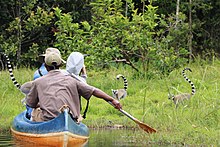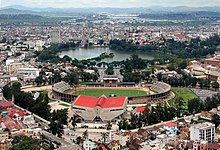Tourism in Madagascar
[1] However, historical sites, craftsmen communities, and relaxed cities make it a favorite with return travellers.
[2] The island is one of the world's most biologically diverse areas, and is internationally renowned as a wildlife tourism and ecotourism destination, focusing on lemurs, birds, and orchids.
A popular route from Antananrivo to Tulear in the south passes through several towns noted for their handicraft: Ambatolampy (aluminium foundry), Antsirabé (gemstones, embroidery, toys), Ambositra (marquetry), and Fianarantsoa.
60% of its tourists are French,[7] who form the majority because of cultural and historical links between the countries, and flight routes.
[8] People who are interested in the country's botany, lemurs,[8] birds,[9] or natural history also make up a large part of its visitors.
The number of tourists in 2002 fell, but the tourism industry subsequently recovered and continued to grow steadily.
Tourism is currently the second-largest foreign exchange earner in the country, and the government hopes to increase this share.
Still in the early stages of development, there is large potential for the tourist industry to grow as Madagascar's infrastructure improves.



